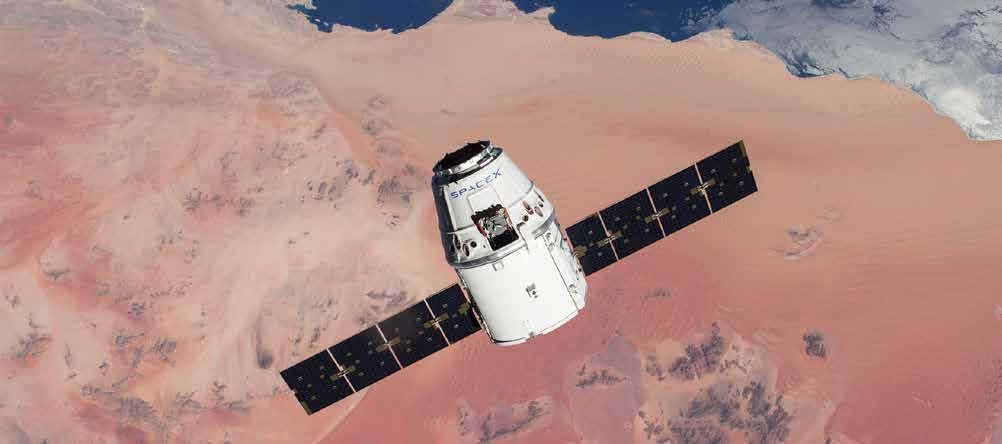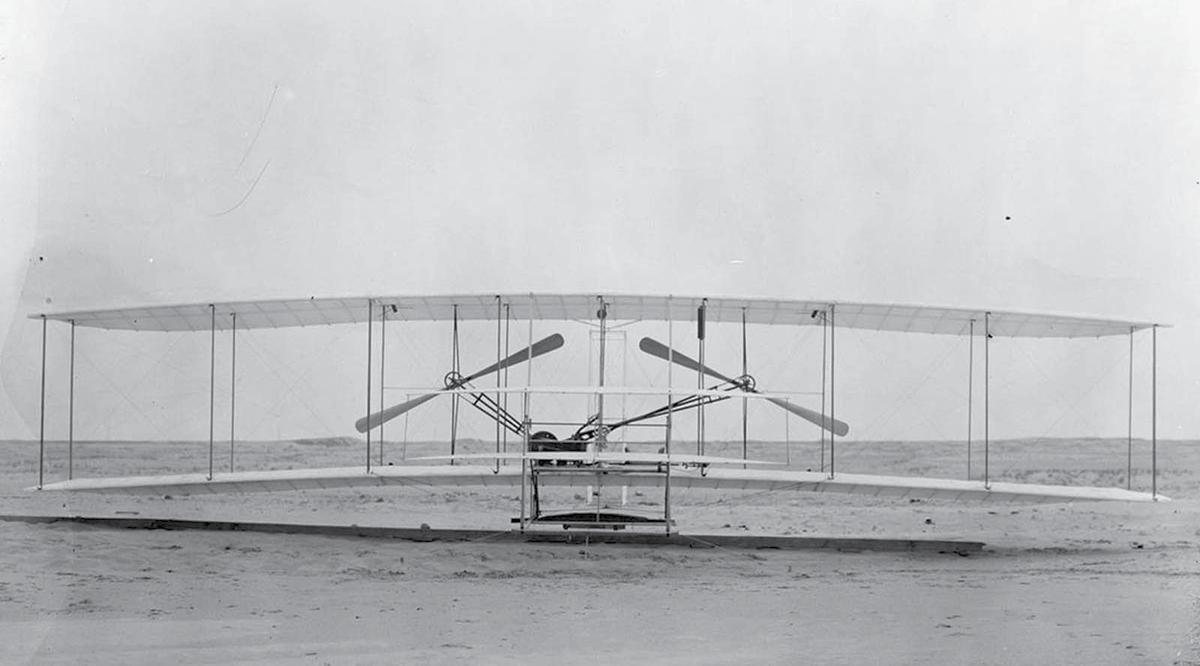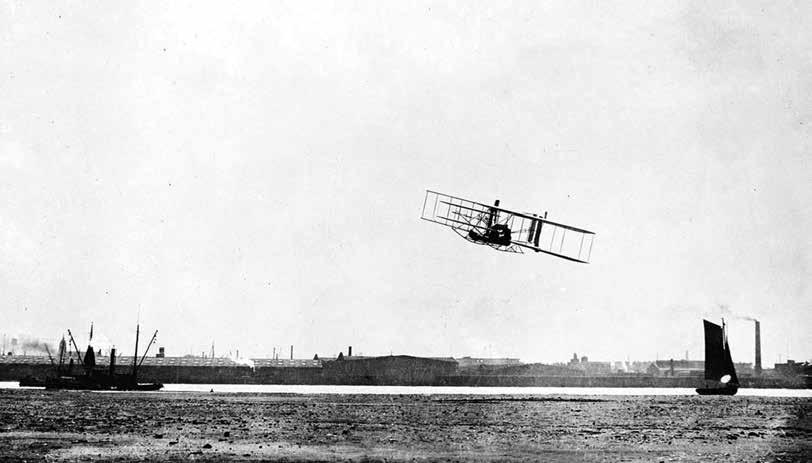
9 minute read
A Bit of History
Cargo Dragon approaching the ISS Image courtesy SpaceX.com
In 1901 American scientist, astronomer, and mathematician Simon Newcomb [1835-1909] “predicted that man would never fly.” Said Newcomb in 1903:
“The desire to fly like a bird is inborn in our race, and we can no more be expected to abandon the idea than the ancient mathematician could have been expected to give up the problem of squaring the circle…The example of the bird does not prove that man can fly.”
Two years later the Wright brothers, Orville [1871-1948] and Wilbur especially [1867- 1912] flew a gasoline-powered heavier-than-air machine over Kitty Hawk, North Carolina. Successfully for 59 seconds. The brothers’ 1903 ascent marked the beginning of aerial navigation.
In May 2020 Space X, entrepreneur Elon Musk’s private venture sent two veteran NASA astronauts— Bob Behnken and Doug Hurley—to the International Space Station [ISS] aboard its “gum-dropped shaped” Crew Dragon spaceship. Space-X’s 29-story, reusable launch rocket is affectionately known as Falcon-9.
NASA’s program goal: to restore American access to space using commercial partners. NASA astronauts Behnken and Hurley remained aboard the ISS for 65 days; until their August 2, 19-hour journey home. The Crew Dragon’s splash down in the Gulf of Mexico was NASA’s first splash down landing in 45 years.
“Since before the space shuttle was retired, NASA has been contracting with private companies to develop
From The Wright Brothers to

Wright Flyer I, built in 1903, front view. This machine was the Wright brothers’ first powered aircraft. The airplane sported two 8 foot wooden propellers driven by a purpose-built 12 horsepower engine. Rare Historical Photos

spacecraft capable of supplying the station with cargo and, at some point in the future, new crews,” former NASAISS astronaut Scott Kelly wrote in 2017. “The most successful private company so far has been Space Exploration Technologies, better known as Space X, which produces the Dragon spacecraft.”
Musk’s “bird” indeed can fly! Like the Wright brothers’ airplanes before. The related principles of space flight and atmospheric flight “are not difficult at all,” right? The study of “these two miracles of modern engineering” is a lesson in physics, technology and history.
“The Wright brothers’ 1903 Flyer 1 [gifted in 1948] will be the brightest gem in the Smithsonian’s collection of aircraft,” The Washington Post reported. “It will hang in an honored spot alongside Charles Lindbergh’s [1927] ‘Spirit of St. Louis.’” The Wrights 1909 military plane was also acknowledged.
“The Wright brothers’ interest in planes began in childhood when their father brought home a toy with a propeller wound up by rubber bands and wings of bamboo and tissue paper,” The Post continued. “It fascinated the boys, who were of mechanical and inventive minds, and they experimented in building others.”
The mechanically inclined brothers formed the Wright Cycle Shop in 1892. The Wrights 1903 airplane was constructed in the rear of the Ohio Shop; then shipped, in sections, to North Carolina for trial. Until 1903, the Wright brothers had tested only gliders.
Wilbur Wright felt flight would fail until such time as man could sustain wings; install a motor and properly control the “bird” in flight. He was the first inventor to equate control inputs—pitch, roll and yaw—with motion.
Wing warping was Wilbur Wright’s solution to airplane control. Twisting the wing surface, he concluded, changed the wing’s position relative to oncoming wind. Such changes in position enabled directional changes. Wright tested his theory by twisting an empty bicycle tube box with the ends removed.
Until the airplane, hot air balloons provided the only means of human flight. Joseph Michel and Jacques Montgolfier invented the hot air balloon in 1783. The Archimedes’ principle is the secret to the balloon’s lift-carrying power. Said General Washington in 1784:
“I have only newspaper Accts of the Air Balloons, to which I do not know what credence to give; as the tales related of them are marvelous, & lead us to expect that our friends at Paris, in a little time, will come flying thro’ the air instead of ploughing ocean to get to America.”
The Wright brothers perfected their flying machine in 1905, but did not begin public demonstrations until a patent was issued in 1908. The U.S. Army agreed to purchase the Wrights’ flying machine for $25,000 provided it could carry two men and enough fuel to complete a 40 miles per hour, 125-mile flight. Military test flights began at Arlington’s, then the County of Alexandria’s Fort Myer in June 1909.
On July 2, 1909, the Alexandria Gazette observed: “Orville Wright late yesterday encircled the Fort Myer drill grounds in his aeroplane in three successful flights. In his last attempt he remained aloft for a few seconds more than nine minutes.”
The nation’s first speed trial, also its first cross country flight occurred on July 30, 1909. Orville Wright successfully flew his machine ten-miles from Fort Myer to Old Town Alexandria’s Shooter’s Hill. The average flight speed was 42-miles per hour, more than the Army’s contractual minimum of 40-miles per hour. Wright’s speedy flight earned the team a $5,000 bonus.
“The truth of the saying, ‘All things come to those who wait,’ was made apparent to Alexandrians at sunset yesterday when [Wright’s] biplane made an aerial run from the parade grounds at Fort Myer as far as the Southern and Washington Railway tracks south of the reservoir of the Alexandria Water Company,” the Alexandria Gazette reported on July 31, 1909. “The engine worked perfectly. The greatest height reached was probably 400 feet above the gully at Four Mile Run.” The biplane rounded the test marker on Shooter’s Hill and returned to Fort Myer in 14 minutes and 42 seconds.
The Wright brothers remained involved with flight until Wilbur’s untimely death in 1912 at age 45. The brothers’ achievements were commemorated in 1932 with the placement of a 60 feet granite statue on North Carolina’s Kill Devil Hill.
From left, Orville and Wilbur Wright, in portraits taken in 1905, when they were 34 and 38 years old.

Wilbur Wright makes a 33-minute-long flight during the Hudson-Fulton Celebration in New York in 1909. A feat witnessed by hundreds of thousands of New York residents. Rare Historical Photos
A BIT OF HISTORY | FROM PAGE 9
From Kitty Hawk’s Kill Devil Hill to Alexandria’s Shooter’s Hill to the International Space Station: as envisioned by President John F. Kennedy. “The ISS is the only object whose components were manufactured by different countries and assembled in space,” former NASA-ISS astronaut Scott Kelly penned. “From the outside the ISS looks like a number of giant empty soda cans attached to each other end to end.” NASA astronauts first boarded the ISS in 1998.
“Think of our world as it looks from the rocket that is heading to Mars,” President Lyndon B. Johnson suggested in 1965. “It is like a child’s globe, hanging in space, the continents stuck to its side like colored maps. We are all passengers on a dot of earth.”
“Looking down at the planet from 200 miles in space, I feel as though I know the Earth in an intimate way most people don’t—the coastlines, terrains, mountains, and rivers,” Kelly continued. “Some parts of the world, especially in Asia, are so blanketed by air pollution that they appear sick, in need of treatment or at least a chance to heal. The line of our atmosphere on the horizon looks thin as a contact lens over an eye, and its fragility seems to demand our protection.”
Orville and Wilbur Wright showed courage and daring when introducing their heavier-than-air machine. The Wright brothers not only gave us flight they, like NASA astronauts Behnken and Hurley gave us hope. Hope as defined by The Oxford American Dictionary: (1) expectation and desire combined; (2) a person, thing, or circumstance that gives cause for hope. The kind of hope found only in dreams.
To dream: to imagine; think of as a possibility; to invent.
“The development that gave America its greatest edge over the Soviets came in 1958 [the Eisenhower era] courtesy of the private sector,” historian Douglas Brinkley wrote. “Working separately, electrical engineers Jack Kilby of Texas Instruments and Royce Noyce of Fairchild Semiconductor invented the monolithic integrated circuit, also known as the microchip… This tiny, integrated circuit would soon lead to the development of portable, efficient, and affordable high-speed communication systems, revolutionizing space exploration.”
In the early 1960s qualified women who dreamed of becoming American astronauts “spoke righteously on behalf of female equality.” Regrettably Ohio reared astronaut John Glenn [Friendship-7] testified against their employment claiming “this gets back to the way our social order is organized.”
Soviet cosmonaut Valentina Tereshkova was the first woman to travel in space— on June 16, 1963. Tereshkova made 48 earth orbits in 70 hours. America’s first female astronaut—Sally K. Ride— departed on June 18, 1983, aboard NASA’s Challenger space shuttle.
The times they are a-changin.’ NASA and Space-X have proven public-private partnerships work. Astronaut Bob Behnken’s wife, NASA astronaut Megan MacArthur will pilot the CrewDragon’s second launch, its return to the ISS in the spring of 2021. A happy result!
Boeing still needs to complete its Starliner capsule’s un-crewed mission; prove its crewed capsule can successfully rendezvous with the ISS. NASA not long ago announced black astronaut Jeanette Apps, astronauts Sunita Williams and Josh Cassada will crew Boeing’s 2021 ISS test flight. The Starliner-1 will launch atop an Atlas-V rocket; the first of Boeing’s six contracted missions.
We also wait for the return of NASA’s spaceship Perseverance. Launched from Cape Canaveral, Florida, on July 30—with a rover and ingenious helicopter drone on board—Perseverance is en route to Mars. The mission’s goal: to further explore the planet’s latent hints of life.
“Like the Wright Brothers moment we are laying the groundwork for sending humans to Mars,” a United Launch Alliance official explained.
Sarah Becker started writing for The Economist while a graduate student in England. Similar publications followed. She joined the Crier in 1996 while serving on the Alexandria Convention and Visitors Association Board. Her interest in antiquities began as a World Bank hire, with Indonesia’s need to generate hard currency. Balinese history, i.e. tourism provided the means. The New York Times describes Becker’s book, Off Your Duffs & Up the Assets, as “a blueprint for thousands of nonprofit managers.” A former museum director, SLAM’s saving grace Sarah received Alexandria’s Salute to Women Award in 2007. Email: abitofhistory53@ gmail.com
AYOUR DVENTURE BEGINS HERE







Quality Sport & Trail Horses For Sale Open Year-Round Lessons • Training •Trail Rides • Special Events





















